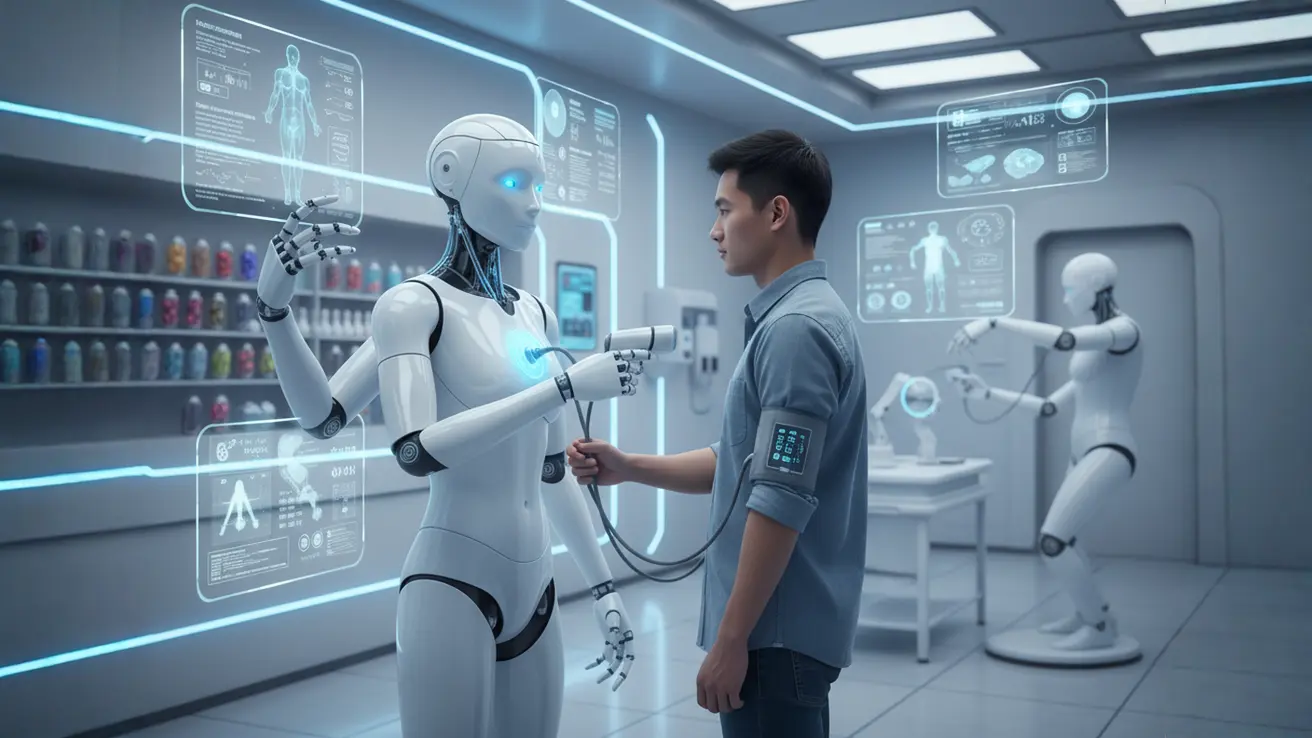Author: Aditya Pareek | EQMint | General News
In a stunning leap forward for global healthcare innovation, China has introduced “doctorless clinics” — fully automated medical facilities run by artificial intelligence and robotics, capable of examining patients, diagnosing diseases, and even dispensing medicines instantly. The development, described by experts as one of the most radical transformations in modern medicine, underscores China’s ambition to lead the world in AI-driven healthcare.
A Glimpse Into the Future of Medicine
The concept of doctorless clinics, once confined to science fiction, has now become a reality. These AI-powered medical hubs are equipped with advanced diagnostic machines, robotic arms, and conversational AI systems that interact with patients seamlessly. Using real-time data analytics, computer vision, and natural language processing, these systems can analyze symptoms, perform scans, recommend treatments, and issue prescriptions without human intervention.
Patients entering these clinics are greeted by humanoid robots and guided through the entire consultation process. The robots can take vital signs — such as heart rate, temperature, and blood pressure — and conduct physical examinations using high-precision sensors. Once the assessment is complete, the system generates a diagnosis and suggests treatment options, often followed by the instant dispensing of prescribed medication through automated pharmacy units within the facility.
China’s Push Toward AI in Healthcare
China has been aggressively investing in artificial intelligence, robotics, and digital infrastructure for over a decade. From smart cities to autonomous logistics, the nation’s technological advancements have rapidly transformed key industries — and healthcare is the latest frontier. The rollout of doctorless clinics aligns with Beijing’s long-term strategy to make healthcare more accessible and efficient, especially in rural and underserved regions.
According to reports from China’s National Health Commission, the government’s goal is to bridge the gap between urban hospitals and remote communities by leveraging automation and AI. In areas where access to qualified doctors is limited, these clinics can provide timely, accurate, and affordable care.
“AI-driven healthcare solutions will help us overcome one of the greatest challenges in modern China — the unequal distribution of medical resources,” said Dr. Liu Wen, a Beijing-based health policy researcher. “Doctorless clinics are not meant to replace human doctors entirely, but to complement them by handling routine diagnostics and freeing medical professionals for complex cases.”
How the Technology Works
The doctorless clinics operate through a combination of AI algorithms, Internet of Things (IoT) devices, and robotic automation. Each unit is powered by a cloud-based data network that stores medical information securely while allowing real-time analysis of millions of patient records.
The process typically involves the following steps:
- Automated Registration: Patients scan their ID or health card to begin a session.
- Symptom Input: Using speech recognition or touch-screen interfaces, patients describe their symptoms.
- Diagnostics: AI algorithms compare symptoms with vast medical databases, analyzing health metrics captured by sensors.
- Consultation: The robot interacts conversationally, explaining possible causes and next steps.
- Prescription & Dispensing: The system issues an e-prescription and dispenses the required medicines immediately.
- Data Storage & Follow-Up: All patient data is encrypted and stored for follow-up or human doctor review when needed.
This integration of technology not only saves time but also significantly reduces operational costs. A single clinic can manage hundreds of patients daily with minimal human supervision.
Advantages of AI-Driven Clinics
The advantages of this innovation are far-reaching:
- Accessibility: Remote regions with doctor shortages can receive quality healthcare services.
- Efficiency: AI systems can process medical data faster than humans, reducing wait times.
- Affordability: Lower operating costs translate into more affordable healthcare for citizens.
- Accuracy: AI diagnostic systems, trained on millions of medical cases, have demonstrated accuracy rates of over 90% in identifying common diseases.
- Scalability: These clinics can be easily replicated across regions without the need for extensive infrastructure.
China’s health technology firms claim that these clinics can handle over 200 common illnesses, ranging from respiratory infections and skin conditions to cardiovascular and neurological assessments.
Ethical and Regulatory Challenges
While the development has been widely celebrated as a breakthrough, it has also raised important questions about ethics, privacy, and accountability. Critics argue that relying heavily on AI for medical diagnosis could pose risks in complex cases where human intuition and empathy play critical roles.
Data security remains another major concern. With sensitive medical records being stored and analyzed by AI systems, ensuring robust cybersecurity protocols is essential. Chinese regulators have already begun drafting guidelines to govern the use of AI in healthcare, emphasizing transparency and patient consent.
“Automation should enhance human healthcare, not replace it entirely,” said Professor Zhang Mei, a bioethicist at Tsinghua University. “We must ensure that the human touch — compassion, understanding, and moral judgment — remains integral to medicine.”
Global Implications
China’s success with doctorless clinics could serve as a blueprint for other nations struggling with healthcare inefficiencies. Countries like Japan, South Korea, and the United Arab Emirates have also been experimenting with robotic healthcare solutions, but China’s implementation at scale marks a turning point.
International observers believe this could reshape global medical practices, especially in the post-pandemic era, where contactless care and automation have become increasingly important. By reducing dependency on human doctors for routine tasks, doctorless clinics could allow health systems worldwide to focus resources on critical care and advanced medical research.
The Human Element: Balancing Innovation and Empathy
Despite its technological marvel, the concept of doctorless clinics highlights a philosophical dilemma — can machines truly replace doctors? While AI can diagnose and treat with precision, patients often seek emotional reassurance and human understanding, which no algorithm can replicate entirely.
Experts suggest a hybrid model as the ideal path forward — one where AI handles diagnostics, logistics, and data processing, while human doctors provide interpretation, empathy, and ethical oversight. This collaboration could redefine the future of healthcare, merging technology with humanity.
The Road Ahead
As China expands its network of AI-driven clinics, global attention will likely intensify on the outcomes — particularly regarding accuracy, patient satisfaction, and safety. If successful, this could mark a pivotal step toward universal, accessible, and efficient healthcare systems worldwide.
For now, China’s doctorless clinics stand as a bold experiment — a glimpse into a future where healthcare meets high technology. Whether they become the new norm or remain a specialized innovation, one thing is clear: the boundaries between man and machine in medicine are being redrawn faster than ever before.
Disclaimer: This article is based on information available from public sources. It has not been reported by EQMint journalists. EQMint has compiled and presented the content for informational purposes only and does not guarantee its accuracy or completeness. Readers are advised to verify details independently before relying on them.




